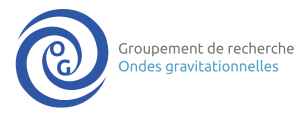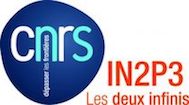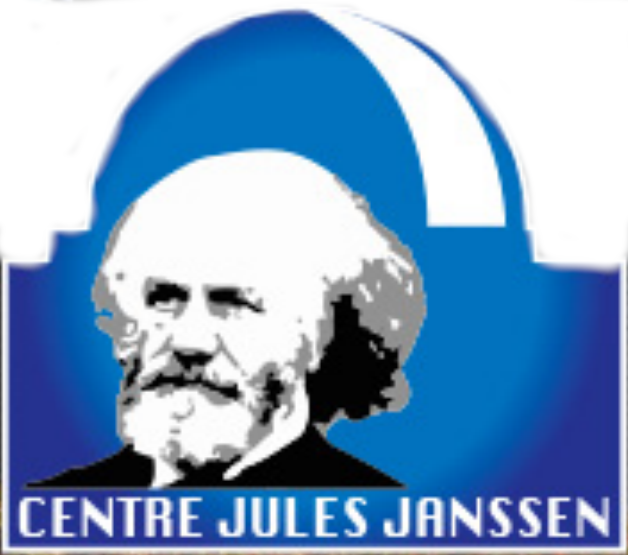Septième Assemblée Générale du GdR Ondes Gravitationnelles
amphithéâtre du bâtiment Evry Schatzman
LUTH, Observatoire de Paris, Meudon
Le GdR Ondes Gravitationnelles (http://gdrgw.in2p3.fr/) a été crée en 2017 avec le but de rassembler la communauté scientifique intéressée par l’exploration de l’Univers avec les ondes gravitationnelles, et de lui fournir des occasions de rencontres et de discussions communes.
La septième assemblée générale du GdR Ondes Gravitationnelles se tiendra en présence au Laboratoire Univers et Théories (LUTH), Observatoire de Paris, à Meudon, et couvrira les thèmes d’intérêt du GdR, représentés par ses Groupes de Travail.
L'inscription à cette réunion est obligatoire avant le 13 septembre 2023. Il faut, au préalable, devenir membre du GdR en s'inscrivant sur le site http://gdrgw.in2p3.fr/ si vous ne l'êtes pas déjà.
La date limite pour envoyer une contribution est le 13 septembre 2023.
En parallèle de l'assemblée générale se tiendra une conférence grand public lundi 16 octobre à 20h30 à Meudon donnée par Fédérique Marion intitulée: Les ondes gravitationnelles ou l'émergence d'une nouvelle astronomie.
Pour plus d'informations et pour vous inscrire à cette conférence grand public (gratuite dans la limite des places disponibles, priorité donnée aux non-spécialistes) : https://indico.obspm.fr/event/1982/
-
-
Buffet d'accueil cafétéria du bâtiment Evry Schatzman
cafétéria du bâtiment Evry Schatzman
LUTH, Observatoire de Paris, Meudon
Observatoire de Paris, site de Meudon - 5, place Jules Janssen, F-92195 Meudon cedex (bâtiment 18 sur le plan ci-dessous) -
Mikel Falxa: Summary of the latest EPTA results amphithéâtre du bâtiment Evry Schatzman
amphithéâtre du bâtiment Evry Schatzman
LUTH, Observatoire de Paris, Meudon
Observatoire de Paris, site de Meudon - 5, place Jules Janssen, F-92195 Meudon cedex (bâtiment 18 sur le plan ci-dessous)Pulsar timing array collaborations have recently presented evidence of nanohertz gravitational waves. These gravitational waves are believed to originate from the inspiralling phase of supermassive black hole binary systems, producing detectable signals at low frequencies. This presentation will provide a basic understanding of pulsar timing arrays and discuss the methods used to identify gravitational wave signals.The focus of this talk will be on the findings from the European Pulsar Timing Array (EPTA) collaboration. We will explore the practical aspects of pulsar timing arrays and share the latest results from EPTA's efforts to detect and study nanohertz gravitational waves.
-
DEVELOPPEMENT DES DETECTEURS amphithéâtre du bâtiment Evry Schatzman
amphithéâtre du bâtiment Evry Schatzman
LUTH, Observatoire de Paris, Meudon
Observatoire de Paris, site de Meudon - 5, place Jules Janssen, F-92195 Meudon cedex (bâtiment 18 sur le plan ci-dessous)-
1
Banc de test ZIFO pour le projet LISAOrateur: Maxime VINCENT (AstroParticule et Cosmologie)
-
2
First results from an end-to-end simulation and analysis pipeline for LISAOrateur: Jean-Baptiste Bayle (University of Glasgow)
-
3
3rd generation detector Einstein TelescopeOrateur: Mme Angélique Lartaux (IJCLab)
- 4
-
1
-
COSMOLOGIE amphithéâtre du bâtiment Evry Schatzman
amphithéâtre du bâtiment Evry Schatzman
LUTH, Observatoire de Paris, Meudon
Observatoire de Paris, site de Meudon - 5, place Jules Janssen, F-92195 Meudon cedex (bâtiment 18 sur le plan ci-dessous)-
5
Cosmology with Dark-Sirens, a review of O3 resultsOrateur: Grégoire Pierra (CNRS Ip2i Ondes gravitationnelles)
-
6
Testing cosmological models with massive black hole binariesOrateur: Alberto Mangiagli (APC)
-
7
Observing Kinematic Anisotropies of a Stochastic Gravitational Waves Background with LISAOrateur: Dr Henri INCHAUSPÉ (Institute for Theoretical Physics, Universität Heidelberg)
-
8
LISA and γ-ray telescopes as multi-messenger probes of a first-order cosmological phase transitionOrateur: Alberto Roper Pol (APC)
-
9
Gravitational wave (GW) turbulence using a multiple time scale methodOrateur: Benoît Gay (LPP)
-
5
-
Pause café cafétéria du bâtiment Evry Schatzman
cafétéria du bâtiment Evry Schatzman
LUTH, Observatoire de Paris, Meudon
Observatoire de Paris, site de Meudon - 5, place Jules Janssen, F-92195 Meudon cedex (bâtiment 18 sur le plan ci-dessous) -
Luca Santoni: Tidal deformability and Love numbers of black holes amphithéâtre du bâtiment Evry Schatzman
amphithéâtre du bâtiment Evry Schatzman
LUTH, Observatoire de Paris, Meudon
Observatoire de Paris, site de Meudon - 5, place Jules Janssen, F-92195 Meudon cedex (bâtiment 18 sur le plan ci-dessous) -
FORMES D’ONDE amphithéâtre du bâtiment Evry Schatzman
amphithéâtre du bâtiment Evry Schatzman
LUTH, Observatoire de Paris, Meudon
Observatoire de Paris, site de Meudon - 5, place Jules Janssen, F-92195 Meudon cedex (bâtiment 18 sur le plan ci-dessous)-
10
Gravitational-wave phasing of compact binary systems to the fourth-and-a-half post-Newtonian orderOrateur: Quentin Henry (Albert Einstein Institut)
-
11
Integrability and action-angle variables of binary black holes at second post-Newtonian orderOrateur: Sashwat Tanay (LUTH, Paris Observatory)
-
12
Relating post-Minkowskian and Bondi-Sachs formalismsOrateur: Roberto Oliveri (LUTH, Observatoire de Paris, CNRS)
-
13
Super-angular momentum at ScriOrateur: Simone Speziale (CPT Marseille, CNRS)
-
10
-
TESTS DE LA RELATIVITÉ GÉNÉRALE ET THÉORIES ALTERNATIVES amphithéâtre du bâtiment Evry Schatzman
amphithéâtre du bâtiment Evry Schatzman
LUTH, Observatoire de Paris, Meudon
Observatoire de Paris, site de Meudon - 5, place Jules Janssen, F-92195 Meudon cedex (bâtiment 18 sur le plan ci-dessous)- 14
- 15
-
16
Exact black hole solutions in higher-order scalar-tensor theoriesOrateur: Nicolas Lecoeur (Université Paris-Saclay, IJCLab, Orsay)
-
17
Compact binary systems in modified gravity theories and their effective-one-body descriptionOrateur: Félix-Louis Julié (Albert Einstein Institute, Potsdam)
-
Diner au buffet restaurant du campus de Meudon (bâtiment no. 4, près de l'entrée véhicules)
restaurant du campus de Meudon (bâtiment no. 4, près de l'entrée véhicules)
LUTH, Observatoire de Paris, Meudon
Observatoire de Paris, site de Meudon - 5, place Jules Janssen, F-92195 Meudon cedex (bâtiment 18 sur le plan ci-dessous)
-
-
-
ÉTOILES A NEUTRONS, SUPERNOVÆ ET SYNTHÈSES DES ÉLÉMENTS LOURDS amphithéâtre du bâtiment Evry Schatzman
amphithéâtre du bâtiment Evry Schatzman
LUTH, Observatoire de Paris, Meudon
Observatoire de Paris, site de Meudon - 5, place Jules Janssen, F-92195 Meudon cedex (bâtiment 18 sur le plan ci-dessous)-
18
The impact of stellar rotation on the gravitational wave signal from supernovaeOrateur: Thierry Foglizzo (AIM, CEA-Saclay)
-
19
Multi-messenger emission and explosive nucleosynthesis from core-collapse supernovaeOrateur: Matteo Bugli (CEA - Saclay)
-
20
Simulating isolated neutron stars with primitive variablesOrateur: Gaël Servignat (LUTH)
-
21
Gravitational waves from neutron stars with a phase transitionOrateur: Dr Marco Antonelli (LPC Caen)
- 22
-
18
-
Pause café cafétéria du bâtiment Evry Schatzman
cafétéria du bâtiment Evry Schatzman
LUTH, Observatoire de Paris, Meudon
Observatoire de Paris, site de Meudon - 5, place Jules Janssen, F-92195 Meudon cedex (bâtiment 18 sur le plan ci-dessous) -
POPULATION DES SOURCES amphithéâtre du bâtiment Evry Schatzman
amphithéâtre du bâtiment Evry Schatzman
LUTH, Observatoire de Paris, Meudon
Observatoire de Paris, site de Meudon - 5, place Jules Janssen, F-92195 Meudon cedex (bâtiment 18 sur le plan ci-dessous)-
23
Multimessenger study of merging massive black holes in the Obelisk simulation: gravitational waves, electromagnetic counterparts, and their link to galaxy and black hole populationsOrateur: Chi An DONG PAEZ (Institut d'Astrophysique de Paris)
-
24
Interpretation of the EPTA Data Release 2Orateur: Hippolyte QUELQUEJAY (Laboratoire Astroparticule et Cosmologie)
-
25
Impact of populations of BBHs on the astrophysical background in 3G detectorsOrateur: Carole Perigois
-
23
-
Raffaele Flaminio: First observations during the O4 run and status of the Virgo detector amphithéâtre du bâtiment Evry Schatzman
amphithéâtre du bâtiment Evry Schatzman
LUTH, Observatoire de Paris, Meudon
Observatoire de Paris, site de Meudon - 5, place Jules Janssen, F-92195 Meudon cedex (bâtiment 18 sur le plan ci-dessous)The LIGO-Virgo-KAGRA O4 run started on May the 24th. In order to improve the detector's sensitivity, the Virgo collaboration decided not to join the run since the beginning and it is continuing the commissioning of the interferometer. During the talk I will first present a summary of the observations made during the first months of the O4 run.
Then I will focus on the present status of the Virgo detector, the plan to join O4 and the preparatory works for O5. -
Discussion amphithéâtre du bâtiment Evry Schatzman
amphithéâtre du bâtiment Evry Schatzman
LUTH, Observatoire de Paris, Meudon
Observatoire de Paris, site de Meudon - 5, place Jules Janssen, F-92195 Meudon cedex (bâtiment 18 sur le plan ci-dessous) -
Déjeuner au buffet cafétéria du bâtiment Evry Schatzman
cafétéria du bâtiment Evry Schatzman
LUTH, Observatoire de Paris, Meudon
Observatoire de Paris, site de Meudon - 5, place Jules Janssen, F-92195 Meudon cedex (bâtiment 18 sur le plan ci-dessous) -
PRÉDICTION ET SUIVI DES SIGNAUX MULTI-MESSAGER amphithéâtre du bâtiment Evry Schatzman
amphithéâtre du bâtiment Evry Schatzman
LUTH, Observatoire de Paris, Meudon
Observatoire de Paris, site de Meudon - 5, place Jules Janssen, F-92195 Meudon cedex (bâtiment 18 sur le plan ci-dessous)-
26
Deep Multimessenger Search for Compact Binary Mergers in LIGO, Virgo, and Fermi/GBM Data from 2016–2017Orateur: Marion Pillas (IJCLab, Université Paris Saclay)
-
27
Multi messenger astronomy: latest results from the Fink brokerOrateur: Dr Julien Peloton (CNRS-IJCLab)
-
28
Follow-up of gravitational wave events: focus on development for SVOMOrateur: Jean-Grégoire Ducoin
- 29
-
26
-
Quentin Baghi: LISA Redbook amphithéâtre du bâtiment Evry Schatzman
amphithéâtre du bâtiment Evry Schatzman
LUTH, Observatoire de Paris, Meudon
Observatoire de Paris, site de Meudon - 5, place Jules Janssen, F-92195 Meudon cedex (bâtiment 18 sur le plan ci-dessous) -
Pause café cafétéria du bâtiment Evry Schatzman
cafétéria du bâtiment Evry Schatzman
LUTH, Observatoire de Paris, Meudon
Observatoire de Paris, site de Meudon - 5, place Jules Janssen, F-92195 Meudon cedex (bâtiment 18 sur le plan ci-dessous) -
MÉTHODES D’ANALYSE DES DONNÉES amphithéâtre du bâtiment Evry Schatzman
amphithéâtre du bâtiment Evry Schatzman
LUTH, Observatoire de Paris, Meudon
Observatoire de Paris, site de Meudon - 5, place Jules Janssen, F-92195 Meudon cedex (bâtiment 18 sur le plan ci-dessous)- 30
-
31
Assessing the Importance of eccentricity and First Post-Adiabatic Terms for Small Mass-ratio BinariesOrateur: Ollie Burke (L2I Toulouse, CNRS/IN2P3, UT3)
-
32
Prototyping a Global-fit Pipeline for LISAOrateur: Senwen Deng (APC)
-
33
Noise characterization for Stochastic Gravitational Wave Backgrounds data analysis with LISAOrateur: Quang Nam DAM (LPC Caen - UNICEAN)
-
34
DeepHMC: Deep Neural Network based Hamiltonian Monte Carlo algorithm for binary neutron stars parameter estimationOrateur: Jules Perret (APC)
-



